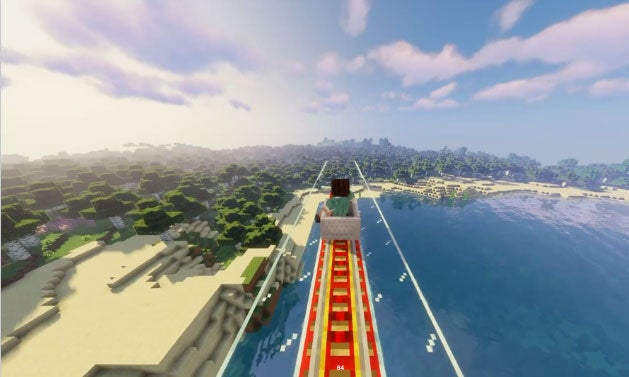KINGSTON, R.I. – October 15 – The popular sandbox video game Minecraft entices players of all ages and genders to explore blocky, procedurally-generated 3D worlds to discover resources, craft tools and items, and build anything they can imagine. College of Arts and Sciences Art professor, and professional printmaker and artist, Travess Smalley, was one of three creators to present at the 2025 Minecraft Live event, where new upcoming features for the game were announced.
Smalley’s art is anchored in rematerialization, a process that translates digital art into physical art. As a printmaker, much of his work is digital with a contemporary approach. Dating back to 2014, Smalley came across a video on the popular streaming service Twitch in which an anonymous streamer wrote a program that moved their Minecraft character in a minecart towards the edge of the “world.”

“What broke my brain was this idea that we’re all looking at right now is procedurally generated. By that set of rules, it’s generating a seemingly infinite world, and I found that really powerful,” says Smalley. “The idea of modifying a game like Minecraft was huge. I was able to take the digital art I had been working on and put it directly into the game.”
During the 2020 pandemic, the McKenzie Art Gallery in Canada ran a Minecraft via Ender.gallery for visiting artists; Smalley was one of them. He took this residency and transformed any ground surface (concrete, grass, etc.) in the game with a never-ending poem, along with a series of digital rugs he had previously created.
Smalley’s work quickly caught the attention of the team at Microsoft, owners of the game. They reached out to include his work in the 2025 MineCraft Live. A team arrived on the Kingston Campus at the end of the summer and captured a day in the life of Smalley at work. The video was shown at Minecraft Live and has amassed over 3 million views.

Originally from West Virginia, from a family of coal miners and bluegrass musicians, Smalley became a first-generation college graduate. He started his education at Virginia Commonwealth University and transferred to Cooper Union in New York City, a small, free art college that focuses on art, engineering, and architecture. Smalley spent the next 15 years in the city showcasing his work at many galleries around the world, including Foxy Production, and Higher Pictures in New York, and the Galerie Andreas Huber in Vienna, Austria.
Eventually, he began commuting to Providence, Rhode Island, to teach at the Rhode Island College of Design (RISD). From there, he enrolled and received a graduate degree in digital media from RISD. From West Virginia to New York to Rhode Island, Smalley was eager to see where he would land next. Ironically, he did not have to go far after securing his current role at URI in 2022.
As a teacher, Smalley’s courses provide a variety of media and skill sets, including risography, pen plotting, cyanotyping, relief printing, bookmaking, xerography, digital printing, and desktop publishing. Smalley is most interested in exploring how images change when they are printed and digitized, and he introduces art students to using computation as part of an art and design practice. His philosophy behind this particular type of generative art-making is equally influenced by computational artists and poets, such as Yoko Ono.
“Cut a hole in a bag filled with seeds of any kind and place the bag where there is wind.”Yoko Ono, “Grapefruit” (1964).
According to Smalley, Yoko Ono is giving a recipe, a set of instructions, to make art. We often think of coding as a strict structure but Yoko Ono’s scripts show that programs can also be abstract and poetic. It is the source of chance and randomness that determines how the “painting” might look. To further that logic, he encourages students who do not major in art to make generative projects with the B.F.A. students. This presents the opportunity for students from a swath of different academic backgrounds to come together and see where the wind takes their creative “seeds.”

“I have marine biology students, natural science students, computer science and math students who are eager to use their hands. Having this variety in the classroom makes the B.F.A. students think differently, and vice versa. I think there are a lot of benefits of a well-rounded education,” says Smalley.
Smalley is also publishing his first book in 2026 titled Pixel Rugs, distributed by Vetro Editions in Berlin. The book will explore monographs and the use of a new printing process that uses fluorescent ink so that prints look as they would on a screen. His work was also recently featured in Architectural Digest.

